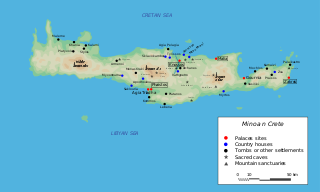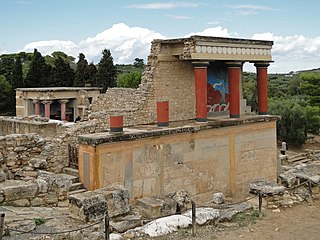
The Minoan civilization was a Bronze Age culture which was centered on the island of Crete. Known for its monumental architecture and its energetic art, it is often regarded as the first civilization in Europe.

Knossos is a Bronze Age archaeological site in Crete. The site was a major center of the Minoan civilization and is known for its association with the Greek myth of Theseus and the minotaur. It is located on the outskirts of Heraklion, and remains a popular tourist destination.

A mountain in north-central Crete, Mount Juktas, also spelled Iuktas, Iouktas, or Ioukhtas, was an important religious site for the Minoan civilization. Located a few kilometers from the palaces of Knossos and Fourni and the megaron at Vathypetro, Mount Juktas was the site of an important peak sanctuary in the Minoan world. At the base of Juktas, at Anemospilia, is a site that has suggested to some that the Minoans practiced human sacrifice, but the evidence is currently somewhat in question.

Karfi is an archaeological site high up in the Dikti Mountains in eastern Crete, Greece. The ancient name of the site is unknown; "Karfi" is a local toponym for the prominent knob of limestone that marks the peak of the site, especially when viewed from the north. Located approximately 1100 meters above sea level, and overlooking the northern entrance to the Lasithi Plateau, the dramatic situation of Karfi is somewhat akin to that of the famous Inca site of Machu Picchu in Peru. While there is some evidence that the site was used during the Middle Minoan period as a peak sanctuary, Karfi is best known as a large and extensively excavated town of the Late Minoan IIIC period at the beginning of the Greek "Dark Ages."

Minoan pottery has been used as a tool for dating the mute Minoan civilization. Its restless sequence of quirky maturing artistic styles reveals something of Minoan patrons' pleasure in novelty while they assist archaeologists in assigning relative dates to the strata of their sites. Pots that contained oils and ointments, exported from 18th century BC Crete, have been found at sites through the Aegean islands and mainland Greece, in Cyprus, along coastal Syria and in Egypt, showing the wide trading contacts of the Minoans.

Minoan peak sanctuaries are widespread throughout the island of Crete (Greece). Most scholars agree that peak sanctuaries were used for religious rites high in the mountains of Crete. Human and animal figurines, as well as signs of religious architecture, have been found at most peak sanctuaries. Additionally, votive clay body parts are found at many of these sites. Many of the sanctuaries fell out of use during the Late Bronze Age, when Mycenaeans from the Greek mainland became the dominant culture on the island.
Modi is the archaeological site of a Minoan peak sanctuary in eastern Crete.

Traostalos is the archaeological site of a Minoan peak sanctuary in eastern Crete.

Sacred caves and peak sanctuaries are characteristic holy places of ancient Minoan Crete. Most scholars agree that sacred caves were used by the Minoans for religious rites, and some for burial. While all peak sanctuaries have clay human figurines, only Idaeon, Trapeza and Psychro have them among the sacred caves. Clay body parts, also called votive body parts, common among peak sanctuaries, appear in no caves with the exception of a bronze leg in Psychro.

Psychro Cave is an ancient Minoan sacred cave in Lasithi plateau in the Lasithi district of eastern Crete. Psychro is associated with the Diktaean Cave, one of the putative sites of the birth of Zeus. Other legends place Zeus' birthplace as Idaean Cave on Mount Ida. According to Hesiod, Theogony, Rhea gave birth to Zeus in Lyctus and hid him in a cave of Mount Aegaeon. Since the late nineteenth century the cave above the modern village of Psychro has been identified with Diktaean Cave, although there are other candidates, especially a cave above Palaikastro on Mount Petsofas.

Tylisos is a town and a former municipality in the Heraklion regional unit, Crete, Greece. Since the 2011 local government reform it is part of the municipality Malevizi, of which it is a municipal unit. The municipal unit has an area of 131.064 km2 (50.604 sq mi). Population 2,867 in 2011. It is an ancient Minoan peak sanctuary and town. The Municipality of Tylisos was created in 1999 and includes 11 villages. The economy is based on agriculture, mainly grape cultivation and olive cultivation. At the same time stock farming of sheep, goats and chickens and beehive farms are abundant.

Atsipades is an archaeological site of a Minoan peak sanctuary in western Crete. It is an open-air peak sanctuary, situated on a mountain and open to the elements. It was discovered by K. Nowicki in 1985.
Vrysinas(βρύσινας) is the archaeological site of an ancient Minoan peak sanctuary.

The Heraklion Archaeological Museum is a museum located in Heraklion on Crete. It is one of the largest museums in Greece and the best in the world for Minoan art, as it contains by far the most important and complete collection of artefacts of the Minoan civilization of Crete. It is normally referred to scholarship in English as "AMH", a form still sometimes used by the museum in itself.

Two Minoan snake goddess figurines were excavated in 1903 in the Minoan palace at Knossos in the Greek island of Crete. The decades-long excavation programme led by the English archaeologist Arthur Evans greatly expanded knowledge and awareness of the Bronze Age Minoan civilization, but Evans has subsequently been criticised for overstatements and excessively speculative ideas, both in terms of his "restoration" of specific objects, including the most famous of these figures, and the ideas about the Minoans he drew from the archaeology. The figures are now on display at the Heraklion Archaeological Museum (AMH).

Minoan religion was the religion of the Bronze Age Minoan civilization of Crete. In the absence of readable texts from most of the period, modern scholars have reconstructed it almost totally on the basis of archaeological evidence of such as Minoan paintings, statuettes, vessels for rituals and seals and rings. Minoan religion is considered to have been closely related to Near Eastern ancient religions, and its central deity is generally agreed to have been a goddess, although a number of deities are now generally thought to have been worshipped. Prominent Minoan sacred symbols include the bull and the horns of consecration, the labrys double-headed axe, and possibly the serpent.

Kommos is an archaeological site in southern Crete. During the Minoan period, it served as a harbour town for nearby Phaistos and Hagia Triada. After the Bronze Age, a sanctuary was built over the ruins of the earlier town. It is notable for providing evidence about international trade and local daily life.
The Archaeological Museum of Agios Nikolaos is a museum in Agios Nikolaos, Crete, Greece. It is currently open on Saturdays and Sundays 09:30 - 15:30 as of 23 April, 2023, and will fully re-open in October 2023.

Minoan art is the art produced by the Bronze Age Aegean Minoan civilization from about 3000 to 1100 BC, though the most extensive and finest survivals come from approximately 2300 to 1400 BC. It forms part of the wider grouping of Aegean art, and in later periods came for a time to have a dominant influence over Cycladic art. Since wood and textiles have decomposed, the best-preserved surviving examples of Minoan art are its pottery, palace architecture, small sculptures in various materials, jewellery, metal vessels, and intricately-carved seals.
Minoan snake tubes are cylindrical ceramic tubes with a closed, splayed out bottom. Sir Arthur Evans interpreted them as "snake tubes", that is vessels for carrying or housing snakes used in Minoan religion. They are now usually interpreted as "offering stands", on which kalathoi, or offering bowls were placed in shrines. They are described as varying in material and construction despite sharing a common purpose. In the context of domestic shrines snake tubes are believed to have sat on top of or adjacent to a cult bench. In between the tubes would have been a goddess figurine and plaque which featured animal depictions.
















